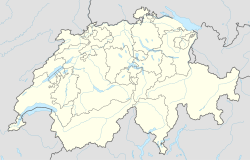Itingen
| Itingen | ||
|---|---|---|
|
||
| Coordinates: 47°28′N 7°47′E / 47.467°N 7.783°ECoordinates: 47°28′N 7°47′E / 47.467°N 7.783°E | ||
| Country | Switzerland | |
| Canton | Basel-Landschaft | |
| District | Sissach | |
| Area | ||
| • Total | 3.14 km2 (1.21 sq mi) | |
| Elevation | 363 m (1,191 ft) | |
| Population (Mar 2016) | ||
| • Total | 2,067 | |
| • Density | 660/km2 (1,700/sq mi) | |
| Postal code | 4452 | |
| SFOS number | 2849 | |
| Surrounded by | Lausen, Ramlinsburg, Sissach, Zunzgen | |
| Website |
www SFSO statistics |
|
Itingen is a municipality in the district of Sissach in the canton of Basel-Country in Switzerland.
Itingen is first mentioned in 1226 as Utingen. In 1454 it was mentioned as Uetingen.
Itingen has an area, as of 2009[update], of 3.14 square kilometers (1.21 sq mi). Of this area, 0.9 km2 (0.35 sq mi) or 28.7% is used for agricultural purposes, while 1.48 km2 (0.57 sq mi) or 47.1% is forested. Of the rest of the land, 0.75 km2 (0.29 sq mi) or 23.9% is settled (buildings or roads) and 0.01 km2 (2.5 acres) or 0.3% is unproductive land.
Of the built up area, industrial buildings made up 3.2% of the total area while housing and buildings made up 9.6% and transportation infrastructure made up 10.5%. Out of the forested land, 43.6% of the total land area is heavily forested and 3.5% is covered with orchards or small clusters of trees. Of the agricultural land, 11.5% is used for growing crops and 13.1% is pastures, while 4.1% is used for orchards or vine crops.
The municipality is located in the Sissach district, in the mid-Ergolz valley. The old village center is located perpendicular to the old cantonal road and to the left of the Basel-Olten rail line.
The blazon of the municipal coat of arms is Gules, a Fish nainaint winged Argent.
Itingen has a population (as of March 2016[update]) of 2,067. As of 2008[update], 15.6% of the population are resident foreign nationals. Over the last 10 years (1997–2007) the population has changed at a rate of 16.5%.
Most of the population (as of 2000[update]) speaks German (1,441 or 89.1%), with Italian language being second most common (60 or 3.7%) and Serbo-Croatian being third (41 or 2.5%). There are 14 people who speak French and 2 people who speak Romansh.
...
Wikipedia




